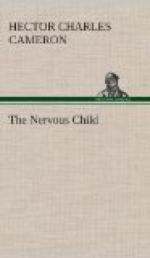If, in spite of our care to avoid unrest and irritation of the child’s brain, sleep is refused, as may often happen, it is, as a rule, wise to cut short the crying if we can, before a vicious circle has been formed and the unrest has been intensified by the emotional storm. It is useless with little children to urge them to go to sleep or to coax. It is not usually wise to leave the child for a little and then to return. Each time the child is left, each time the mother or nurse returns, the crying bursts forth again with renewed force and vigour. It is at least one good plan with a little child to turn the light out, and, treating the whole incident in the most matter-of-fact way possible, lightly to stroke his head or pat his back rhythmically without speaking. With older children, if the crying is more purposeful and less emotional, the mother may busy herself for a little with some task in the room, ostentatiously neglecting the storm and making no reference to it. If she speaks to the child at all she should do so in a matter-of-fact way, referring lightly to other matters. If only she can convince him that his conduct is a matter of indifference to her, the victory is won. It is because the child knows so well that his mother does care that he so often has the upper hand. It is not difficult to distinguish between a true emotional storm and the tyrannous cry of a wilful child who demands his own way.




